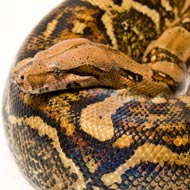New blood test for deadly snake disease

IBD affects snakes in captivity, as well as those sold as pets.
A simple blood test has been developed to screen for inclusion body disease (IBD), a debilitating and usually fatal disease most commonly found in boa constrictors.
Scientists from the University of Florida's College of Veterinary Medicine developed the test by studying a unique protein that accumulates in the cells of snakes with IBD.
While the cause of the disease remains unclear, the team found links between the protein and a family of viruses that predominantly infect rodents, but may also affect humans. According to researchers, however, there is no evidence to suggest people can become infected with the virus causing IBD.
The disease is highly infectious and is first said to have been seen in snakes in the late 1970s. The disease affects both animals in captivity and those sold as pets throughout the world. Pythons and other snake species from the boid family can also occasionally become infected disease-causing virus.
Co-author Elliott Jacobson, professor of zoological medicine at the university, said: "We don’t know the prevalence, but we see more of IBD in the United States because there are some 2 million boas being kept as pets in this country."
Snakes infected with the disease may shows neurological signs such as head-tilting, chronic regurgitation or disequilibrium. However, a population of snakes are subclinical, appearing healthy despite being infected with IBD.
Dr Jacobson explained: "That’s a big problem, because healthy-seeming animals that are affected with IBD are being sold and sent around the world. However, they may develop the disease sometime later and may be the source of infection for other snakes."
The new test is now being offered at the university's veterinary diagnostic laboratories. It is intended to be used alongside existing molecular and histological tests, which are more readily available, but also more expensive.
Researchers say the blood test will provide veterinary surgeons with a first-line diagnostic tool to screen for IBD in animals displaying signs of the disease, or even before signs occur.
Golden gate virus was discovered by researchers from the University of California-San Francisco in 2012, and scientists now believe it could be a cause of IBD. However, Dr Jacobson says further research is needed to confirm this.



 The BSAVA has opened submissions for the BSAVA Clinical Research Abstracts 2026.
The BSAVA has opened submissions for the BSAVA Clinical Research Abstracts 2026.